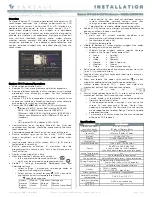
5015SLR Flat Panel Industrial Touch Monitor Chapter 2 – Installation
7
144812(D)
Location and Enclosure Considerations
•
Account for the unit dimensions and operational thermal environment when selecting
an installation location or enclosure (see page 3, 11, and 28 for unit dimensions and
thermal specifications).
•
You can maintain the NEMA 4 seal by mounting the unit in an approved enclosure
that has a 14-gauge (0.075"/1.9 mm thick) steel or (0.125"/3.2 mm thick) aluminum
front face.
•
Place the unit at a comfortable working level.
•
Mount the unit in an upright position, if possible.
•
Consider locations of accessories such as AC power outlets and lighting (interior
lighting and windows) for installation and maintenance convenience.
•
Prevent condensation by installing a thermostat-controlled heater or air conditioner.
•
Avoid obstructing the airflow to allow for maximum cooling.
•
Place any fans or blowers close to the heat-generating devices. If using a fan, make
sure that outside air is not brought inside the enclosure unless a fabric or other
reliable filter is used. This filtration prevents conductive particles or other harmful
contaminants from entering the enclosure.
•
Do not select a location near equipment that generates excessive electromagnetic
interference (EMI) or radio frequency interface (RFI) (equipment such as high-power
welding machines, induction heating equipment, and large motor starters).
•
Do not place incoming power line devices (such as isolation or constant voltage
transformers, local power disconnects, and surge suppressers) near the system. The
proper location of incoming line devices keeps power wire runs as short as possible
and minimizes electrical noise transmitted to the unit.
•
Make sure the location does not exceed the unit's shock, vibration, and temperature
specifications (see
Environmental Specifications
on page 26).
•
Install the unit so it does not cause a hazard from uneven mechanical loading.
•
Incorporate a readily accessible disconnect device in the fixed wiring on permanently
connected equipment.
•
Avoid overloading the supply circuit.






























